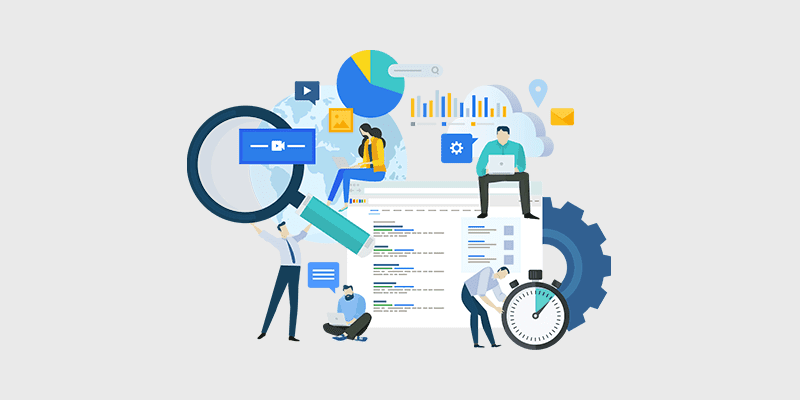I started blogging with the intent of recording my findings in the tech world and educating others of the beauty of a still relatively hidden field to many (software engineering). I initially started blogging on Medium and enjoyed it so much I decided to make my own. I decided to research on how I can go about blogging successfully and here's what I found.

Let's unload these two facts.
First off, what do I mean by blogging successfully?
I define success in a blog as traffic on search engines having high exposure to my content. How is that typically accomplished? A blogger who dove into the technical weeds a bit would know that the key lies behind SEO, performance, and content planning. Of course, I knew this was relevant. But I wanted to go into detail, given my understanding was surface level when it came to the specifics of content structuring. I am overly technical when it came to Google's Indexing Algorithm so I understand how the algorithm is implemented, but not so much on how to provide information in the most efficient way for the web crawlers.
With that, here is what I investigated and dove into!

SEO (Search Engine Optimization)
SEO is coined as the process behind improving the quality and quantity of website traffic to a website or a web page from search engines.
SEO applies to three critical areas, your website structure, your website content, and backlinking.
Now, if you're a blogger on Medium exclusively, don't worry too much about the website structure part. Medium does the heavy lifting here for you. If you own a blog website listen up! When I mention structure, I mean details that typically make for quick changes but can lead to a serious improvement in discoverability.
Website Structure Improvements
- Metadata (adding meta tags like title, description, language, etc)
- Alt attributes to Images
- HTML Element usage (primarily H1-H6 tags)
- Content consistency across mobile + web
- Quality images (but not too large file sizes)
Some not as quick changes have to do with Google's priorities when it comes to indexing.
- Mobile web first (Responsive Design)
- Performance (load times) - don't lazy load critical content!
- CDN (Content Delivery Network) for images
- SSR (Server Side Rendering) as opposed to CSR (Client Side Rendering)
Of course, there are many more improvements that can be made, but these seemed like the gist to get to scores of 80% SEO optimization and higher. I will go over a few of these suggestions and why they play a role in reaching our desired audiences.
Let's focus first on discussing the quick fixes for SEO.
The way Google ranks content according to queries is through the usage of web crawlers. Web crawlers are bots that go through the literal billions of websites found on Google. These bots follow set guidelines that help determine how to rank all of these websites. That being said, structuring the bones of your website with meta tags that include title and description helps the crawlers understand the intent or purpose of your website. Providing heading tags H1-H6 defines the order and the key takeaways of your content. It also has the bonus of helping your fast readers parse the text in the way they prefer, so having this type of structuring is a win-win for the bots and for your readers. Finally, alt attributes tell the crawlers what the content of your image is because they can't explicitly see for themselves!
Now let's go over the changes that take some heavy lifting to implement.
Approximately one year ago, Google changed from desktop to mobile-first indexing. That means that the crawlers will look at your website in a mobile web context first and if it doesn't look good there, well, then you're in a bit of a pickle when it comes to ranking. Responsive design can be tricky to add for a well-established website, given the transition in layout from multiple columns to a forced single-column. But there is no denying, it's a time-proven fact that the majority of people browse on their phones now. So this change in priority for Google's indexing didn't come without reason, and the adjustment is only for the benefit of your website viewers. For performance, the load time for the pages on your website is critical. Just think about how you interact with slow websites. If a page takes a couple of seconds to come up, do you stay or exit? You'd probably only stay on excruciatingly slow websites if you were in dire need of using the clunky experience. You'd stay on slow websites like the DMV or your Electric Utility Company because you have to pay your bills or register your vehicle. But you wouldn't be happy to stay on lazy non-performant sites like these.
Now that we understand the user by putting ourselves in their shoes, we can see why performance matters. Reducing your bounce rate and encouraging stronger user retention is critical, website performance is vital to these metric improvements, and that is why the googles indexing algorithm takes your website's performance into account.

How do we improve performance?
Here are just a few ways:
- Move images to a CDN
- Improve API response times
- Minify Javascript and CSS files
- Clean up unnecessary packages
- Use a fast web host
- Decrease image sizes
- Caching (Frontend & Backend)
- Reduce font variation
- Pre-rendering
- Pre-fetching
SSR (Server Side Rendering) vs CSR (Client Side Rendering) is a big topic. In a nutshell, Client-Side Rendering is when all of the Javascript is rendered on your user's browser. Server-Side Rendering is when all of this occurs on the server, so your client's browser has everything it needs and is ready to go immediately. Because of this, the web crawlers have the fully-fledged website up faster for them to parse. Therefore, Server Side Rendering plays directly into the Performance (load times) case.
Website Content Improvements
Now let's talk about the content that goes into our website. What we put into our blog posts not only requires research on what to discuss but also which wording we want to use to make google and our web searchers happy.
Simply put, we want to supply the information that people are using search engines for. How do we do that? We need to research what people are even asking in the first place! This is where keywords relevance comes into play.
Let's say you want to talk about the benefits of eating Thai curry. When you type Thai curry into Google search, what you get are a bunch of topics around recipes for Thai curry! That being said, if your article mentions the benefits of eating curry, you're providing an answer to questions nobody asked for in the first place. This is why research prior to writing is so important.
You want to provide relevant, new information for the questions people are asking. The inclusion of relevant keywords around these topics helps Google determine the weight of accuracy in your pieces, and keywords serve to summarize the content of your writings. These keywords can be extensively researched through several online tools. Ahrefs, Google's Keyword Planner, and Semrush are just a few of those resources.
Another detail to note when researching keywords with these third party tools are long tail keywords. Long tail keywords are the specific questions individuals tend to research when they are close to converting or making a purchase. Long tail keywords are gold mines for bloggers as they tend to have lower competition online. If you want to better understand long tail keywords and how you can use them to drive up the discoverability of your content, check out this detailed article that breaks it all down.
Finally, it helps to write about a niche. If nobody is talking about a certain topic and you're an expert in that topic, you're in a perfect position. People will eventually go to Google questions about your topic and you will go unchallenged by competitors. Only you can provide the answer, so you would get exclusive access to all of that traffic!
One such example of a blog that focuses on a particular niche, is that of a mechanical engineer who writes about plastic pipes and flanges. Because the blogger focuses on a topic not widely discussed online, their mechanical engineering blog gets premium access to those looking for that specific information. As a result of focusing on a niche topic, they attract thousands of daily organic visitors!
Ok, so this is a summary of what I've researched on approach for my blog for a relative level of success. Now we come to the part where I decided to build my blog.
Building my own personal blog

Why did I decide to do it?
Well, first off, I'm a Frontend Developer! So, I figured why not! I love working on projects and this sounded like a fun challenge. With the newfound knowledge of how my content should be served to users, I went to thinking about the design of my blog and searched for the relevant technologies that can give me things like server-side rendering, fast web hosts, ease of responsive handling, and more. After coming up with that list I went to building and recently went through the launch of my personal website.
What are the benefits to having my own blog you may ask?
Although it requires work to maintain, I do this for a living, so it's not too heavy on the learning for me. But I get to tailor my posts however I want to, which is very very cool. If I want a quiz in the middle of my article for more hands-on learning? I can add one. If I want to have syntax highlighting for the code I've written? I've got it! I can go as far as my creativity goes, which is a luxury.
Another plus to having my own personal blog is that I can establish a more direct relationship with my viewers. People won't say "I found this awesome post on Insert Third Party Website here they'll mention ByteSizedPieces! The theming, styles, structure of the website are all catered to my preference and topic of discussion. The list goes on.
If you are enjoying ByteSizedPieces, please feel free to ask me any questions you may have. I am working on an article that thoroughly goes through the technologies I used and why I chose them, so stay tuned for that!
Thanks for reading and for your support, I wish you the best in your blogging adventure!
Until then, happy coding!
Remember, developers are creatures that turn coffee into code. So I'd very much appreciate if you bought me a coffee!  I’m a new writer and I will be posting very frequently on my findings and learnings in the tech industry and beyond. Join my newsletter if you would like to stay tuned!
I’m a new writer and I will be posting very frequently on my findings and learnings in the tech industry and beyond. Join my newsletter if you would like to stay tuned!
Thanks for reading again! ❤️
| Understand Open Graph Dynamic Image Meta Tags | 1 |
| Pros and Cons of Caching Data in Software | 2 |
| How to build a Modal in ReactJS (Part One) | 3 |
